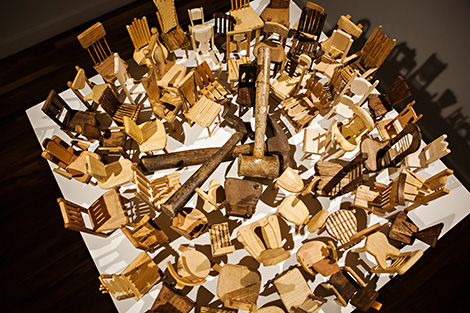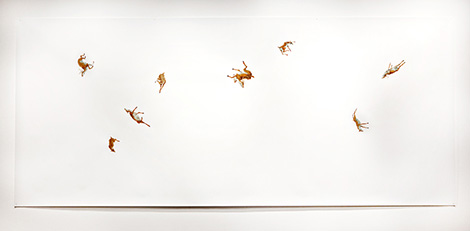“Domesticating Disturbances,” Nathan Huff’s solo exhibit of drawings and paintings in gouache and sculpture/installation never dogmatically adheres to a set of organizing principles, instead freely adapting ideas to form a unique figurative language. His point of departure is the Jungian shadow lurking inside individuals and society collectively—that unself-conscious, amoral core that represents the individual’s repressed behaviors and the greatest source of innovation, insight and power.
The sensitively painted surfaces and elegant draftsmanship of Huff’s works on paper exert a satisfying and seductive power. When he reaches beyond literal correlations or visual/linguistic puns, his work offers unusual associations and poetic juxtapositions. Florescent Divine (2014) and Torque (2010) shift into this ambiguous territory, with depictions of deer in various attitudes, as if unencumbered by gravity; they strike a supple tension between our desire for rational thought and an unconscious non-linguistic state of rapture.
Although Huff does not directly engage in shamanistic practices like Joseph Beuys’ iconic performances, Marcus Coates’ trance-like consultations with animal spirits, or Oleg Kulik’s controversial canine persona, his exploration of animals as substitutes for human presence relates to Jung’s concept of the shaman as a conduit to the collective unconscious—the deepest part of the shadow that all individuals share.
Huff alternately explores the competing urges for rationality and ecstasy. His site-specific installation Up a Creek and Down River (2014) creates tension within the rarified gallery space—itself a kind of Plato’s cave—with a representation of flowing water that forms a figurative meditation on thought and cultural discourse. An ordinary hose bib protrudes from the side of a sculptural pedestal. Below it, a meandering serpentine fan of tumblers, glasses and goblets half-filled with water suggests a stream made from the artifacts of civilization. Atop the glasses at varying intervals, exquisitely crafted balsawood boats of diverse shapes and sizes reference the nascent beginnings of ancient trade. Inasmuch as these vessels represent utilitarian objects for exploiting natural resources, they are also an ancient means of communication between distant and diverse populations and a mode of exploring the vastness of the Earth. Mythologically and symbolically, they represent ways of venturing into the unknown, a journey into the self and an encounter with the Other.
Shop Talk (2014) features a multitude of hand-built model-scaled chairs, also in balsawood, of various designs (including notable Arts and Crafts and Eames designs). A kind of classroom in the round is formed by the chairs, focusing on a readymade trio of well-used hammers. The assembly conjures the fever of academic discourse, the art studio and the “crit.” But more than just “shop talk,” this virtual assembly references the ongoing discourse within which Huff inserts his work—equally as object and idea—and considers the delicate balance between the individual and the collective. In the tension between reason and transcendence, Huff finds the shaman essential. As Beuys remarked, “In places … where everyone speaks so rationally, it is necessary for a kind of enchanter to appear.” In Huff’s work the shaman is implied as healer and visionary.





















0 Comments